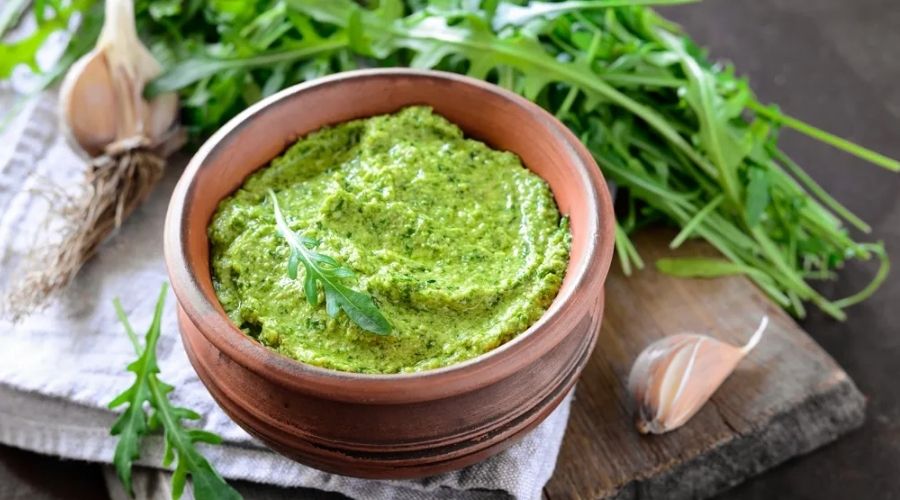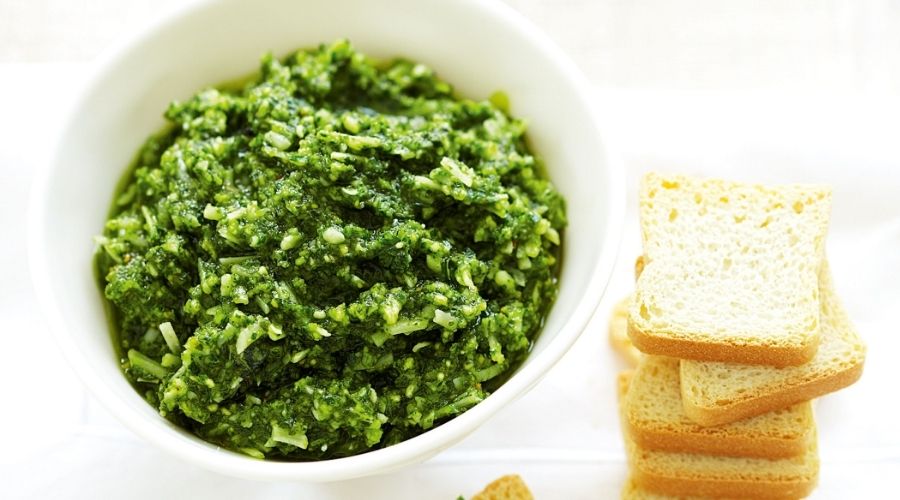Basil pesto is a beloved ingredient known for its vibrant flavor and versatility in dishes ranging from pasta to sandwiches.
However, there are times when basil might not be available or you might want to explore different flavor profiles.
Whether you’re looking for a nut-free option, a different herbal twist, or a way to use up other ingredients, there are plenty of basil pesto substitutes that can bring unique flavors to your meals.
In this article, we’ll explore over 12 excellent alternatives to basil pesto, each offering its own distinctive taste and texture.
From spinach and kale to nut-free and dairy-free versions, you’ll find a range of options to suit your dietary needs and culinary preferences.
12+ Delicious Basil Pesto Substitute You Need to Try
Whether you opt for the peppery kick of arugula pesto, the nutty richness of sunflower seed pesto, or a dairy-free variation, each substitute brings its own flair to your recipes.
By experimenting with these alternatives, you can enhance your meals with fresh and exciting flavors, while accommodating dietary restrictions or simply enjoying a new twist on a classic favorite.
Embrace the diversity of these pesto substitutes and elevate your dishes with creativity and confidence.
Spinach Pesto
Spinach pesto is a versatile substitute for basil pesto that offers a fresh and slightly different flavor profile.
Made from spinach, nuts (such as pine nuts or walnuts), garlic, Parmesan cheese, and olive oil, this alternative maintains a similar texture and rich, savory taste.
Spinach pesto works well in recipes where you want to retain the pesto’s creamy consistency but with a milder flavor.
It is especially suitable for pasta dishes, sandwiches, and as a dip. However, spinach pesto lacks the distinct basil aroma, so it may alter the flavor profile of your dish.
To balance this, consider adding a touch of fresh herbs like mint or parsley.
Arugula Pesto

Arugula pesto provides a peppery, slightly spicy twist to the traditional basil pesto.
Made with arugula leaves, nuts, garlic, Parmesan cheese, and olive oil, this substitute delivers a robust and vibrant flavor.
Arugula pesto is excellent for adding a bit of zing to your dishes, making it suitable for pasta, grilled vegetables, or as a topping for meats.
Be cautious about the intensity of the arugula’s flavor, as it can be quite bold compared to basil.
Adjust the amount of arugula used to achieve a balanced taste that complements your recipe without overpowering it.
Also Read: 12+ Best Butter Pecan Cake Mix Substitutes You Need to Try!
Cilantro Pesto
Cilantro pesto offers a unique and fresh alternative to basil pesto, especially for those who enjoy the distinctive flavor of cilantro.
This substitute uses cilantro leaves, nuts (such as cashews or almonds), garlic, Parmesan cheese, and olive oil to create a bright and flavorful paste.
Cilantro pesto is perfect for adding an exotic twist to dishes like tacos, grilled chicken, or rice bowls.
Keep in mind that cilantro has a strong flavor that can dominate the dish, so use it sparingly and adjust other seasonings accordingly. This pesto works well in recipes where you want to introduce a fresh, herbal note.
Sun-Dried Tomato Pesto
Sun-dried tomato pesto is a rich and tangy alternative to traditional basil pesto.
Made from sun-dried tomatoes, nuts, garlic, Parmesan cheese, and olive oil, this pesto offers a robust and slightly sweet flavor with a deep tomato essence.
It is ideal for adding a burst of flavor to pasta, sandwiches, or as a topping for roasted vegetables.
While it provides a different taste compared to basil pesto, its vibrant and concentrated tomato flavor can enhance various dishes.
Be cautious with the amount of sun-dried tomatoes used, as their intense flavor can sometimes overshadow other ingredients. Adjust seasoning and ingredient proportions to balance the overall taste.
Kale Pesto
Kale pesto is a nutritious alternative to traditional basil pesto, featuring the hearty, slightly bitter flavor of kale. To make kale pesto, blend kale leaves with nuts (such as almonds or walnuts), garlic, Parmesan cheese, and olive oil.
This substitute offers a robust flavor and maintains the creamy texture of classic pesto, making it a great choice for pasta dishes, spread on sandwiches, or drizzled over roasted vegetables.
Kale pesto can be more bitter than basil pesto, so adjust the seasoning with a bit more cheese or a touch of honey to balance the flavors.
This version is particularly suitable for adding a nutrient boost to your meals.
Herb Pesto

Herb pesto, made from a combination of fresh herbs like parsley, mint, and dill, provides a vibrant and aromatic substitute for basil pesto.
This blend of herbs offers a complex flavor profile that works well in a variety of dishes.
To prepare herb pesto, blend the mixed herbs with nuts (such as pine nuts or pistachios), garlic, Parmesan cheese, and olive oil.
Herb pesto is perfect for brightening up pasta, drizzling over grilled meats, or as a flavorful dip.
Since the flavor profile of herb pesto can vary based on the herbs used, it’s a good idea to taste and adjust seasoning to ensure it complements your dish.
Also Read: 12+ Sugar-Free Corn Syrup Substitutes for Healthier Baking!
Red Pepper Pesto
Red pepper pesto is a colorful and flavorful alternative to basil pesto, featuring roasted red peppers as its base.
To make this pesto, blend roasted red peppers with nuts (such as almonds or cashews), garlic, Parmesan cheese, and olive oil.
This substitute adds a sweet, smoky flavor to your dishes and works well in pasta, as a spread for sandwiches, or as a topping for grilled fish.
The natural sweetness of red peppers can create a different taste experience compared to basil pesto, so be mindful of balancing the sweetness with the saltiness of the cheese and seasoning. This pesto is ideal for adding a unique twist to your recipes.
Pistachio Pesto
Pistachio pesto is a rich and nutty alternative to traditional basil pesto, using pistachios as the primary nut ingredient. To make pistachio pesto, blend shelled pistachios with fresh basil or spinach, garlic, Parmesan cheese, and olive oil.
This pesto offers a creamy texture and a distinct nutty flavor that pairs well with pasta, seafood, or as a spread on bread.
The richness of pistachios can add a luxurious touch to your dishes.
Be cautious with the amount of pistachios used, as their strong flavor can sometimes overshadow other ingredients. Adjust the quantities of basil or spinach to ensure a well-balanced pesto.
Almond Pesto
Almond pesto offers a nutty twist on the classic basil pesto, using almonds as the primary nut ingredient.
To make almond pesto, blend almonds with fresh basil or spinach, garlic, Parmesan cheese, and olive oil. This substitute provides a slightly sweet and creamy flavor that pairs beautifully with pasta, roasted vegetables, or as a topping for grilled meats.
Almond pesto has a distinct, mild nutty flavor that can enrich your dishes without overpowering them. However, almonds can be more subtle than other nuts, so you may need to adjust the seasoning to ensure the pesto’s flavor shines through.
Walnut Pesto

Walnut pesto is a flavorful alternative to basil pesto that features the rich and earthy taste of walnuts.
To prepare walnut pesto, blend walnuts with fresh basil or arugula, garlic, Parmesan cheese, and olive oil. This substitute provides a robust and slightly bitter flavor that complements a variety of dishes.
Walnut pesto works well in pasta dishes, as a spread for sandwiches, or as a topping for grilled vegetables.
Be mindful of the walnuts’ strong flavor, which can be more intense than basil. Adjust the proportions of other ingredients to achieve a balanced and harmonious taste.
Greek Yogurt Pesto
Greek yogurt pesto is a lighter and tangy alternative to traditional basil pesto.
Made by combining Greek yogurt with fresh herbs like basil or parsley, garlic, nuts (such as almonds or pine nuts), and a splash of olive oil, this version provides a creamy texture with a tangy flavor.
Greek yogurt pesto is suitable for those seeking a lower-fat option while still enjoying the richness of pesto. It works well as a dip, a sauce for pasta, or a topping for grilled meats.
The tanginess of Greek yogurt can be quite pronounced, so adjust the seasoning to ensure a balanced flavor that complements your dish.
Also Read: 12+ Dry Italian Dressing Mix Substitutes for Every Dish!
Sunflower Seed Pesto
Sunflower seed pesto is an excellent nut-free substitute for basil pesto, utilizing sunflower seeds as the main ingredient.
To make sunflower seed pesto, blend sunflower seeds with fresh basil or spinach, garlic, Parmesan cheese, and olive oil.
This alternative offers a nutty and slightly sweet flavor with a creamy texture, making it ideal for those with nut allergies.
Sunflower seed pesto is great for pasta dishes, sandwiches, or as a drizzle over vegetables.
Since sunflower seeds have a milder flavor compared to nuts, you might need to adjust the seasoning to enhance the overall taste and ensure it complements your dish.
How to Make a Basil Pesto Substitute at Home
When basil is not available, making a basil pesto substitute at home can be a delicious and versatile solution.
This recipe provides a step-by-step guide to creating a flavorful alternative that captures the essence of traditional pesto.
Whether you prefer spinach, kale, or another herb-based pesto, these substitutions can be used in a variety of dishes, from pasta to sandwiches, ensuring you still enjoy the rich, savory flavors of pesto.
Ingredients:
- 2 cups of fresh spinach or kale leaves (or a combination of both)
- 1/2 cup of nuts (pine nuts, walnuts, or almonds)
- 2 cloves of garlic, minced
- 1/2 cup of grated Parmesan cheese (or a vegetarian alternative)
- 1/2 cup of olive oil
- Juice of 1/2 lemon (optional, for added brightness)
- Salt and pepper to taste
Instructions:
- Prepare the Ingredients: Wash and dry the spinach or kale leaves thoroughly. If using nuts with shells, shell them before proceeding.
- Blend the Base: In a food processor, combine the spinach or kale, nuts, and minced garlic. Pulse until the mixture is finely chopped and well combined.
- Add Cheese and Oil: Add the grated Parmesan cheese to the food processor. With the processor running, slowly drizzle in the olive oil until the mixture reaches a smooth, creamy consistency. If you prefer a thinner pesto, add more olive oil as needed.
- Season and Adjust: Taste the pesto and adjust the seasoning with salt and pepper. For a bit more brightness, you can also add the lemon juice. Pulse again to combine the added ingredients.
- Store or Use: Transfer the pesto to an airtight container and store it in the refrigerator for up to a week. Alternatively, use it immediately in your favorite recipes.
Recipe Conclusion
Creating a basil pesto substitute at home offers a flexible and flavorful way to enjoy pesto even when basil is unavailable.
By using ingredients like spinach, kale, or other herbs, you can maintain the rich, savory quality of traditional pesto while catering to different dietary needs or preferences.
This recipe not only provides a delicious alternative but also allows for creative experimentation with various herbs and nuts.
With this homemade substitute, you can confidently enhance your dishes with the classic pesto experience, ensuring that your meals remain flavorful and satisfying.
1. Can I use spinach pesto as a substitute for basil pesto?
Yes, spinach pesto is an excellent substitute for basil pesto. Spinach provides a mild, slightly sweet flavor and a similar texture to basil.
To make spinach pesto, blend fresh spinach with garlic, nuts (such as pine nuts or walnuts), Parmesan cheese, and olive oil.
This alternative works well in recipes that require pesto, like pasta or sandwiches.
Keep in mind that spinach pesto may not have the same aromatic quality as basil pesto, so you might want to adjust the seasoning to suit your taste.
2. What is a good nut-free alternative to basil pesto?
For a nut-free alternative to basil pesto, consider using sunflower seed pesto. Sunflower seeds offer a similar creamy texture and nutty flavor without the allergens found in nuts.
To make sunflower seed pesto, blend sunflower seeds with fresh basil or spinach, garlic, Parmesan cheese, and olive oil.
This substitute is perfect for those with nut allergies and can be used in the same way as traditional basil pesto in pasta, sandwiches, and dips.
3. Can I use cilantro pesto instead of basil pesto in recipes?
Cilantro pesto can be used instead of basil pesto, though it will impart a distinct flavor profile due to cilantro’s unique taste.
To make cilantro pesto, blend cilantro leaves with garlic, nuts (such as cashews or almonds), Parmesan cheese, and olive oil.
This alternative works well in dishes where cilantro’s fresh and zesty flavor complements the other ingredients, such as in tacos or grilled meats.
Keep in mind that cilantro pesto will significantly alter the flavor of your dish compared to traditional basil pesto.
4. Is it possible to use kale pesto as a substitute for basil pesto?
Yes, kale pesto is a viable substitute for basil pesto. Kale provides a hearty, slightly bitter flavor and a similar texture.
To make kale pesto, blend fresh kale with garlic, nuts (such as almonds or walnuts), Parmesan cheese, and olive oil.
This alternative adds a robust taste to your dishes and is great for pasta, sandwiches, and roasted vegetables.
Be cautious with the bitterness of kale; you might want to balance it with a bit of honey or additional seasoning to achieve the desired flavor.
5. Can I use arugula pesto in place of basil pesto?
Arugula pesto is a flavorful substitute for basil pesto, offering a peppery and slightly spicy kick.
To prepare arugula pesto, blend arugula leaves with garlic, nuts (such as pine nuts or walnuts), Parmesan cheese, and olive oil.
This alternative adds a bold flavor to your dishes and works well in pasta, as a spread for sandwiches, or drizzled over grilled vegetables.
The strong flavor of arugula can be quite pronounced, so adjust the quantity and seasoning to ensure it complements your recipe.
References
- https://www.loveandlemons.com/vegan-pesto/
- https://thestonesoup.com/pesto-substitutes/
- https://www.quora.com/Whats-a-good-substitute-for-basil-in-pesto-sauce
- https://cooking.stackexchange.com/questions/109769/whats-a-good-substitute-for-basil-in-pesto-sauce
- https://www.reddit.com/r/Cooking/comments/p5ftpx/best_pesto_alternative_no_basil_no_pine_nuts/


